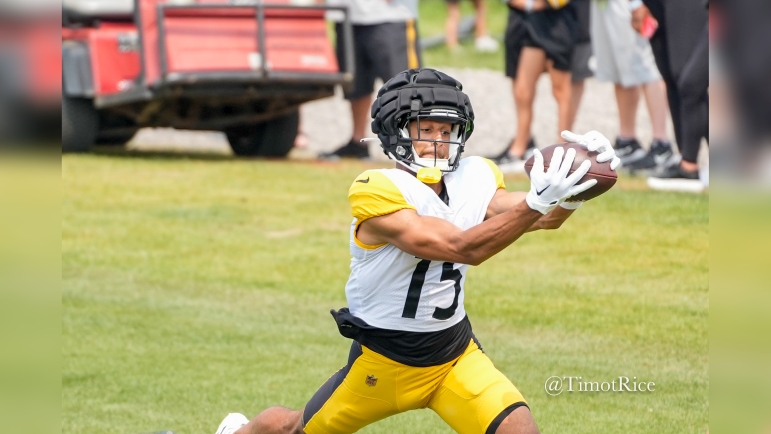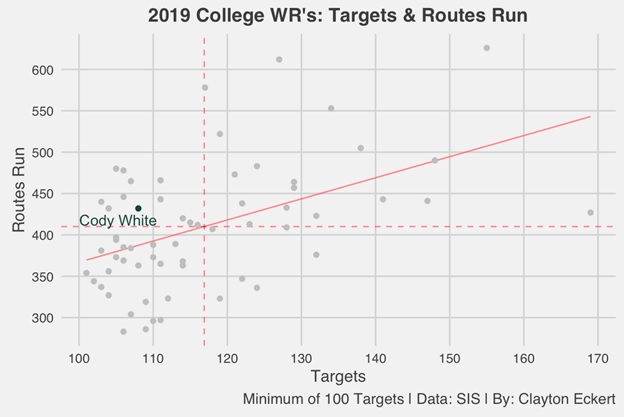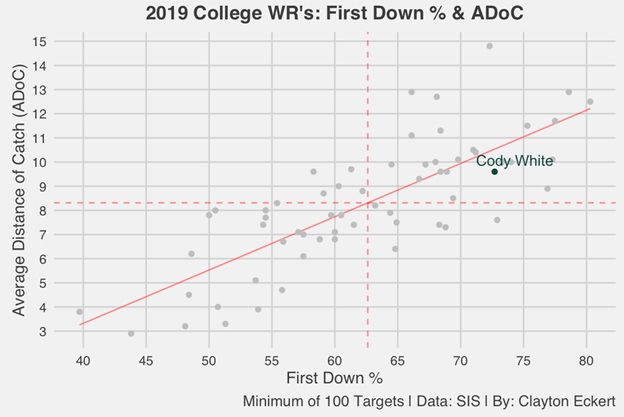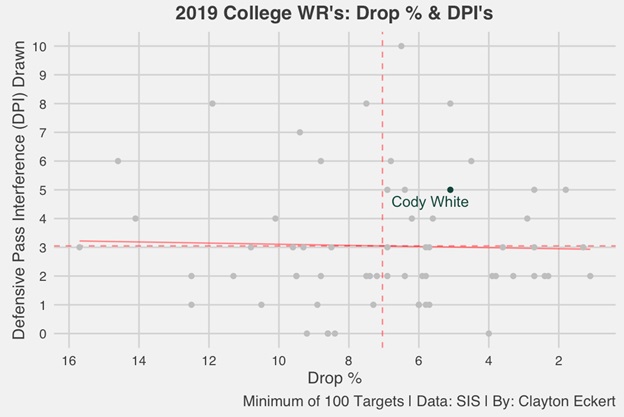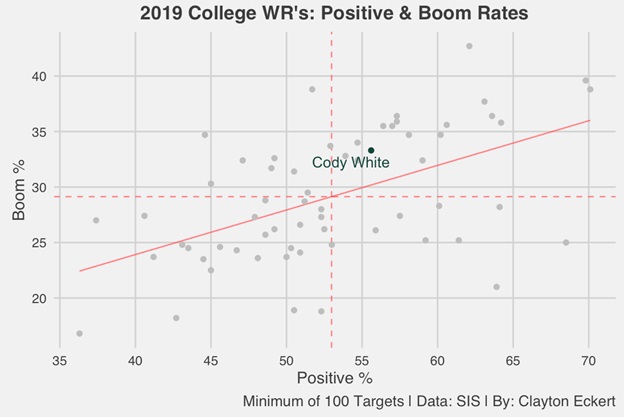With 2023 training camp underway, the goal of these articles is to take news we are hearing, be it a quality practice, where players are lining up, etc., and using that as a launching board to learn more about our 2023 Pittsburgh Steelers. One caveat before I dive in: We, of course, do not want to make huge proclamations in the short term so we can see how the entirety of camp unfolds.
With our own Alex Kozora doing a fantastic job as usual keeping us up to date on what is happening in his training camp diaries, he has mentioned a consistent camp so far for wide receiver Cody White. I wanted to dive in and learn more about him today.
Pro Bio: White signed with the Chiefs as an undrafted free agent following the 2022 NFL Draft, but his time there was short-lived, along with short stints with the Giants and Broncos that season. He was waived from each squad before the season began. White signed to Pittsburgh’s practice squad shortly thereafter, where he stuck for the rest of the year. In 2021, he was promoted to the 53-man roster and saw his first NFL action in Week Three, appearing in eight games but playing just 77 offensive snaps. White stuck around similarly in 2022, but saw even less opportunity, just 10 snaps in one game played. So, just 87 snaps across two seasons with Pittsburgh, and did not play an NFL game in 2020.
Definitely not much of a sample to work from but out of curiosity I looked at some numbers from Pro Football Focus in 2021, when White played more: six targets, five receptions, one drop, 33 yards, 60.1 offensive grade, 56.2 pass grade, with an 84 run-block grade that particularly piqued my interest. Diving further into this, he had one particularly strong run-blocking game against Denver (91.3), according to PFF, with his other seven games each in the low 60s. White also had a strong 86 run-block grade in 2022, but important to recall just 10 total snaps in one game played against the Colts and catching his one target for two yards.
With this low of an NFL sample size, I wanted to look at White’s final college season with Michigan State in 2019, to see if we could learn more. I looked at several data points from Sports Info Solutions (SIS), looking at the 62 wide receivers who had 100 targets that year, which White achieved: 108 targets (T-41st), 432 routes run (T-23rd), 66 catches (T-44th), 922 receiving yards (39th), six touchdowns (T-37th), 634 air yards (29th), 1,133 intended air yards (41st), 288 yards after catch (49th), 129 yards after contact (44th), five defensive pass interferences drawn (T-10th), 61.1 percent completion rate (44th), 90 percent on target catch rate (T-33rd), 5.1 percent drop rate (T-16th), 2.1 yards per route run (46th), 8.5 yards per target (36th), 14 yards per reception (27th), 70.9 yards per game (42nd), 72.7 percent first down rate (10th), 87.8 receiver rating (56th), 10.5 average distance of target (T-34th), 9.6 average distance of catch (T-20th).
Many of White’s marks landed average or below average in the ranks, but let’s visualize some areas he excelled in, starting with routes run and targets:
Here we see White provided good availability in 13 games with the Spartans in 2019. His 432 routes run tied for 23rd out of the 62 qualifying wide receivers (minimum of 100 targets), and he had 108 targets (T-41st), which was more than I expected since I admittedly did not watch him closely in college. The trendline does highlight White being targeted well below average than many of his peers though, given his higher number of routes run.
Next up, first down rate and average distance of catch:
One of the best marks for White was landing in the top 10 of qualifying wide receivers in first down rate, at 72.7 percent (10th). He fared well with a 9.6 average distance of catch as well (T-20th). Moving the chains and coming down with catches downfield are obviously very valuable skills he excelled in. This would obviously be welcomed by the Steelers if he can instill confidence by continuing to stack strong training camp practices, and possibly provide this at the NFL level if things go well and opportunities present themselves.
Here’s a visual of drop rates and defensive pass interferences drawn (DPI):
White had a 5.1 percent drop rate that tied for 16th, and drew five pass interference penalties, which tied for 10th most. For some, these are stats that can get lost in the shuffle, particularly defensive pass interference penalties. These are valuable hidden yardage plays that can impact games greatly. White is listed at 6-foot-3, likely playing into his strong result in college, but NFL defensive backs are bigger, stronger, faster, while of course being smarter and better, so likely not as translatable. If White is able to earn a roster spot, the skill I would expect to translate in more opportunity would be his drop rate, though he unfortunately did drop his one of his seven career NFL targets to date.
White also fared well in a couple of SIS value metrics, positive percentage (passes thrown to a player the resulted in a positive expected points added) and boom percentage (targets that resulted in an expected points added of at least 1, which is a very successful play for the offense):
In terms of high impact plays from an EPA perspective, White fared well for Michigan State. His 55.6 positive percentage ranked 23rd among his peers, along with his 33.3 percent boom rate (measuring even more impactful plays) ranked 18th. Some of his other strong suits in 2019 aid these strong results, with the biggest difference to the extreme top right wide receivers obviously being touchdowns (White had six), including Ja’Marr Chase and Justin Jefferson. The former LSU Tigers led the pack with 20 and 18 touchdowns, respectively, and are now two of the best receivers in the NFL.
So, White’s receiving numbers that stuck out most positively his final college season were first down rate (10th), drawing pass interference penalties (T-10th), a low drop rate (T-16th), average distance of catch (T-20th), availability (T-23rd in routes run), 14 yards per reception (27th), high air yardage comparatively (29th), on 108 targets (T-41st). Many more of his marks were average to below average of the list of wide receivers, but we get a great sense of what he excelled at, while his lowest mark was receiver rating (56th). Of course, this was a long time ago and the NFL is a different animal, but some things he excelled in are attractive and were interesting to learn.
There are obviously a handful of candidates competing to fill out the Steelers’ depth chart at wide receiver. As noted at the beginning of the article, the goal today was not to make any major proclamations. I hope you enjoyed learning more about White and what he could possibly provide if things play out well for him the rest of training camp. One thing’s for sure, I can’t wait to see how things pan out at wide receiver for the Pittsburgh Steelers in 2023.
Thanks for reading and let me know your thoughts in the comments.

